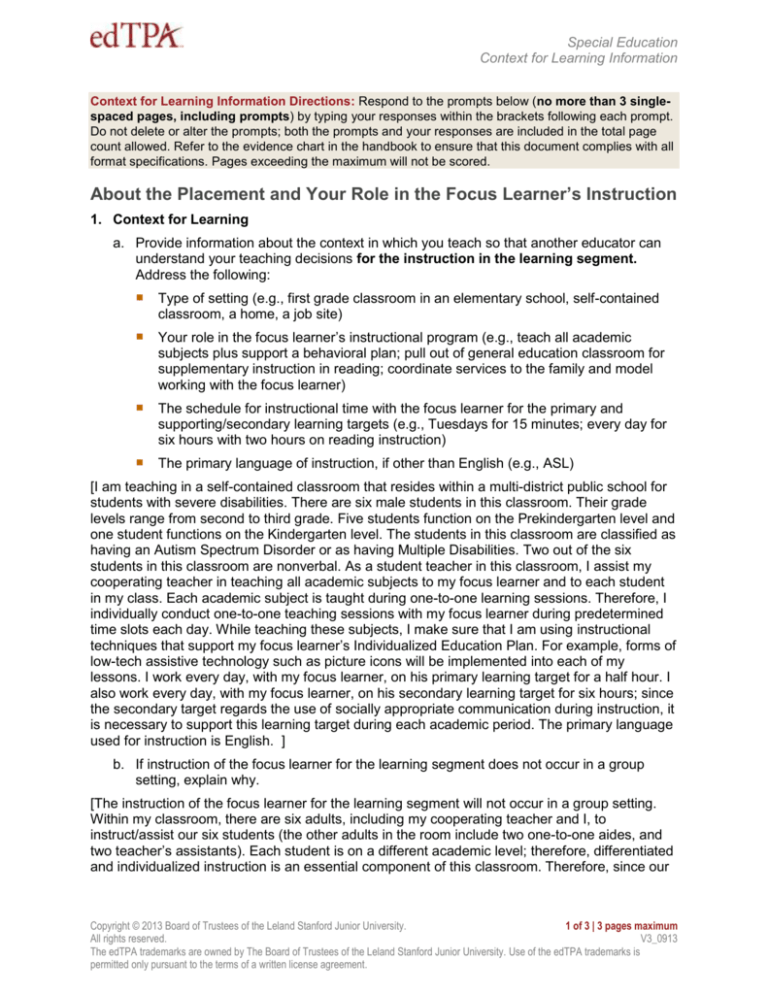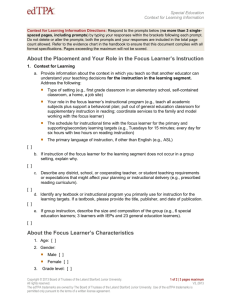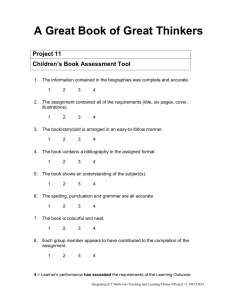
Special Education
Context for Learning Information
Context for Learning Information Directions: Respond to the prompts below (no more than 3 singlespaced pages, including prompts) by typing your responses within the brackets following each prompt.
Do not delete or alter the prompts; both the prompts and your responses are included in the total page
count allowed. Refer to the evidence chart in the handbook to ensure that this document complies with all
format specifications. Pages exceeding the maximum will not be scored.
About the Placement and Your Role in the Focus Learner’s Instruction
1. Context for Learning
a. Provide information about the context in which you teach so that another educator can
understand your teaching decisions for the instruction in the learning segment.
Address the following:
Type of setting (e.g., first grade classroom in an elementary school, self-contained
classroom, a home, a job site)
Your role in the focus learner’s instructional program (e.g., teach all academic
subjects plus support a behavioral plan; pull out of general education classroom for
supplementary instruction in reading; coordinate services to the family and model
working with the focus learner)
The schedule for instructional time with the focus learner for the primary and
supporting/secondary learning targets (e.g., Tuesdays for 15 minutes; every day for
six hours with two hours on reading instruction)
The primary language of instruction, if other than English (e.g., ASL)
[I am teaching in a self-contained classroom that resides within a multi-district public school for
students with severe disabilities. There are six male students in this classroom. Their grade
levels range from second to third grade. Five students function on the Prekindergarten level and
one student functions on the Kindergarten level. The students in this classroom are classified as
having an Autism Spectrum Disorder or as having Multiple Disabilities. Two out of the six
students in this classroom are nonverbal. As a student teacher in this classroom, I assist my
cooperating teacher in teaching all academic subjects to my focus learner and to each student
in my class. Each academic subject is taught during one-to-one learning sessions. Therefore, I
individually conduct one-to-one teaching sessions with my focus learner during predetermined
time slots each day. While teaching these subjects, I make sure that I am using instructional
techniques that support my focus learner’s Individualized Education Plan. For example, forms of
low-tech assistive technology such as picture icons will be implemented into each of my
lessons. I work every day, with my focus learner, on his primary learning target for a half hour. I
also work every day, with my focus learner, on his secondary learning target for six hours; since
the secondary target regards the use of socially appropriate communication during instruction, it
is necessary to support this learning target during each academic period. The primary language
used for instruction is English. ]
b. If instruction of the focus learner for the learning segment does not occur in a group
setting, explain why.
[The instruction of the focus learner for the learning segment will not occur in a group setting.
Within my classroom, there are six adults, including my cooperating teacher and I, to
instruct/assist our six students (the other adults in the room include two one-to-one aides, and
two teacher’s assistants). Each student is on a different academic level; therefore, differentiated
and individualized instruction is an essential component of this classroom. Therefore, since our
Copyright © 2013 Board of Trustees of the Leland Stanford Junior University.
1 of 3 | 3 pages maximum
All rights reserved.
V3_0913
The edTPA trademarks are owned by The Board of Trustees of the Leland Stanford Junior University. Use of the edTPA trademarks is
permitted only pursuant to the terms of a written license agreement.
Special Education
Context for Learning Information
students have a diverse range of needs in regards to learning, our classroom is highly
structured and focuses on one-to-one instruction. ]
c. Describe any district, school, or cooperating teacher, or student teaching requirements
or expectations that might affect your planning or instructional delivery (e.g., prescribed
reading curriculum).
[Components of applied behavior analysis are used within my classroom. Thus, during my
instruction, I will implement components of applied behavioral analysis by using a checklist to
collect data on my focus learner’s achievement and behavior, providing immediate feedback,
and using positive reinforcement to support my focus learner’s learning. All checklists will be
used as daily assessments. Furthermore, my classroom follows the TEACCH methodology for
students with Autism and related disorders, which is from the University of North Carolina. This
method focuses on one-to-one instruction, short learning activities, the use of symbols/icons,
and the use of embedded schedules to help encourage students to stay on task. Embedded
schedules inform students of how many tasks they have left to complete during a lesson. Since
my focus learner is only familiar with the TEACHH method as his form of instruction, he is used
to completing short learning tasks and has not been taught lessons that include an explicit
modeling portion, a guided reading activity and means of self-assessment. However, I will be
implementing these elements into the short learning tasks of my lessons; so, my focus learner’s
unfamiliarity with these elements might affect his behavior and achievement levels. My
cooperating teacher wanted me to start practicing these elements with my focus learner
because he is the highest functioning in my class. Therefore, my learning segment lessons will
be the first time that he is exposed to these elements. In regards to my learning targets, I
collaborated with my cooperating teacher to select comprehension has the primary focus of my
lessons because this is one of my focus learner’s main annual goals on his Individualized
Education Plan. In regards to academic materials, my school uses a prescribed science
curriculum called Science Fusion. I will be adapting this curriculum when planning my learning
segment lessons. Displaying comprehension of my adapted scientific texts will be my focus
learner’s primary learning target. Also, my cooperating teacher generally uses “laptop time” as
positive reinforcement for my focus learner; therefore, I will be supporting this technique during
my lessons. Since computer is used as a form of reinforcement, my cooperating teacher does
not want me to use it as an instructional tool during my learning segment lessons. ]
d. Identify any textbook or instructional program you primarily use for instruction for the
learning targets. If a textbook, please provide the title, publisher, and date of publication.
[I will be adapting information from the Level 2 book of the Science Fusion program as part of
my instruction for the primary learning target. However, this actual textbook will not be read
during my learning segment lessons. The title of this textbook is Science Fusion: New Energy
for Learning, the publisher is Houghton Mifflin Harcourt Publishing Company and the text was
published in 2012.]
e. If group instruction, describe the size and composition of the group (e.g., 6 special
education learners; 3 learners with IEPs and 23 general education learners).
[The instruction for my focus learner will not occur in a group setting.]
About the Focus Learner’s Characteristics
1. Age: [7]
2. Gender:
Male [X]
Copyright © 2013 Board of Trustees of the Leland Stanford Junior University.
2 of 3 | 3 pages maximum
All rights reserved.
V3_0913
The edTPA trademarks are owned by The Board of Trustees of the Leland Stanford Junior University. Use of the edTPA trademarks is
permitted only pursuant to the terms of a written license agreement.
Special Education
Context for Learning Information
Female [ ]
3.
Grade level: [My focus learner is a second grade student but he functions on a
Kindergarten level.]
4. Primary language:
English [X]
Bilingual in English and other language (please identify): [ ]
Other language (please identify): [ ]
5. List any type of augmentative or alternative communication used by the learner (e.g.,
communication boards, signing, AlphaSmart keyboard, optical-character-recognition
devices, speech generation technology).
[My focus learner is verbal; therefore, he mostly uses an oral form of communication. However,
he also uses a Picture Exchange Communication System as an augmentative form of
communication. Within the classroom, icons are used to help him understand what appropriate
classroom behavior he should be exhibiting, to help him express that he has completed a task
and/or to assist him in understanding what activity he will be completing next. Additionally,
picture aids are incorporated within the text of worksheets that he has to complete in order to
assist in his understanding of the material.]
Copyright © 2013 Board of Trustees of the Leland Stanford Junior University.
3 of 3 | 3 pages maximum
All rights reserved.
V3_0913
The edTPA trademarks are owned by The Board of Trustees of the Leland Stanford Junior University. Use of the edTPA trademarks is
permitted only pursuant to the terms of a written license agreement.








